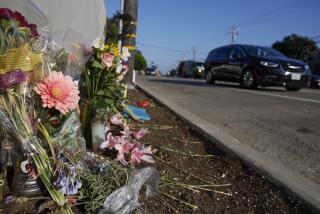Worker’s Death Spurs Caltrans Safety Drive
- Share via
Alarmed by the death of one employee and the serious injury of another this month while they worked on Interstate 5 at night, California Department of Transportation officials are forming a committee to determine if all possible precautions are being taken to protect Caltrans employees on local highways.
The committee, which will have its first meeting later this week, will consist of local officials from Caltrans, the California Highway Patrol and Associated General Contractors of America, which represents the majority of highway workers.
The two separate incidents raise “serious questions about the advisability of working at night,” Caltrans spokeswoman Shirley Weber said Monday. On March 16, David Hoffman, 30, became the 23rd person killed since 1970 while working on a Caltrans highway project in California.
“You try to (work at night) for the convenience of the traveling public, but there are more drunks at night, more people fall asleep at the wheel and there is less visibility,” Weber said. “I know in Hoffman’s case there was a sign one mile away and we had three flashing signs.”
The committee will “monitor” all nighttime projects to be sure that the work could not possibly be done in the day, said Jack Grasberger, Caltrans chief deputy district director who will head the committee.
“A vast majority of our work is done during the day, but certain types of projects are best to do at night,” Grasberger said. “We have all kinds of safety standards and I am sure we have been very stringent about them, but we also want to be sure.”
These standards include such things as placing initial warning signs to passing drivers about 1,000 feet away from the construction area for each lane it occupies. There are also flashing arrows and, at night, flashing signs along the route. In the Hoffman accident, the initial sign was one mile from the construction area and there were three flashing signs in between, Weber said.
Caltrans officials say several studies have shown that drivers do not slow down when passing construction areas. Although there are usually no signs stating exactly how much a driver should slow down, CHP officials say they will do what they can to enforce “safe” speeds in construction areas.
Ben Killingsworth, chief of Caltrans’ border division, said more time will be spent trying to get drivers to slow down in construction areas.
“Enforcement is good, but public understanding and awareness is much better,” he said.
More to Read
Sign up for Essential California
The most important California stories and recommendations in your inbox every morning.
You may occasionally receive promotional content from the Los Angeles Times.













